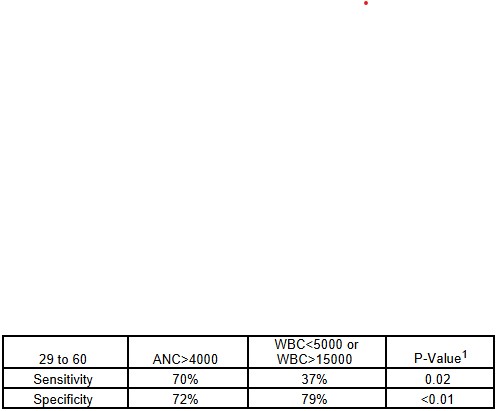Hospital Medicine 5: Clinical
Session: Hospital Medicine 5: Clinical
532 - Utility of Absolute Neutrophil Count versus White Blood Cell Count to Predict Invasive Bacterial Infections in Febrile Infants 8-60 days old
Sunday, April 27, 2025
8:30am - 10:45am HST
Publication Number: 532.7062
Ashley Bartlett, Phoenix Children's Hospital, Scottsdale, AZ, United States; Jared Kusma, Phoenix Children's, Phoenix, AZ, United States; Richard Engel, Phoenix Children's Hospital, Phoenix, AZ, United States; Jillian Wall, Phoenix Children's Hospital, Phoenix, AZ, United States; Maheshwor Kafle, Phoenix children’s hospital, Phoenix, AZ, United States; Quinney Fu, Phoenix Children's, Phoenix, AZ, United States; Jennifer Stamp, Phoenix Children's Hospital, Phoenix, AZ, United States; Jacob Phouthavong-Murphy, Phoenix Children's Hospital, Tempe, AZ, United States; Sandra Gage, Phoenix Children's Hospital, Racine, WI, United States

Ashley Bartlett, Medical Degree (MD) (she/her/hers)
Third Year Categorical Pediatric Resident
Phoenix Children's Hospital
Scottsdale, Arizona, United States
Presenting Author(s)
Background: Febrile infants pose a clinical challenge given their increased risk of invasive bacterial infection (IBI). Guidelines for evaluation are evolving but typically incorporate inflammatory markers such as absolute neutrophil count (ANC) and white blood cell count (WBC). The most recent American Academy of Pediatrics (AAP) guidelines for febrile infants additionally suggest risk stratifying by age. While prior studies have demonstrated the superiority of utilizing ANC over WBC in identifying IBI, there is a lack of research into whether this value is sustained when stratified by age group.
Objective: Compare sensitivity and specificity of ANC vs WBC in identifying IBI in febrile infants, stratified by age subgroups.
Design/Methods: Retrospective cohort study of infants with fever≥38°C presenting to a tertiary center 1/1/2018–12/31/2023. ICD-10 codes for fever/bacterial infections were used for patient identification. Exclusions: prematurity < 37 weeks, previous intensive care stay, prior antibiotic use, known source of fever that is not an IBI, complex care conditions, or ANC, WBC, and/or culture results unavailable. Data collected: age, ANC, WBC, and blood/cerebrospinal cultures. High-risk thresholds: ANC>4000 and WBC < 5000 or >15000. Age groups divided per AAP febrile infant protocol (8-21 days-old (DO), 22-28DO, 29-60DO). Considered IBI+ if culture positive, treating physician documented the infection as true, and patient received appropriate antibiotic course. Sensitivity and specificity calculated and compared using McNemar methodology.
Results: 3682 infants identified, 2113 remained after exclusion criteria. 56 infants (2.7%) IBI+ (8-21DO, 26; 22-28DO, 3; 29-60DO, 27). The two younger groups were combined due to the small sample size in the 22-28 age group. Overall, ANC had greater sensitivity than WBC in identifying IBI (69% vs. 38%; p-value=0.03) but poorer specificity (68% vs 79%; p-value < 0.01) (Table 1). The greater ANC sensitivity and poorer specificity when compared to WBC remained similar for both the 8-29DO and 29-60DO groups (Tables 2 and 3 respectively).
Conclusion(s): While the overall incidence of IBI is low in febrile infants, missed infections can have severe consequences. Our study demonstrated ANC is more sensitive than WBC in febrile infants aged 8-60DO when risk stratified by age, arguing that ANC should be utilized over WBC. While our study was limited in its ability to evaluate the 3 separate age groups outlined in the AAP guidelines, the consistency of data between the 2 age groups studied provides reassurance of the validity of these factors in predicting the presence of IBI.
Table 1. Absolute Neutrophil Count vs White Blood Cell sensitivity and specificity in febrile infants 8-60 days old
 1McNemar Test
1McNemar Test ANC: Absolute Neutrophil Count
WBC: White Blood Cell
Table 2. Absolute Neutrophil Count vs White Blood Cell sensitivity and specificity in 8-28 day-old febrile infants
 1McNemar Test
1McNemar Test ANC: Absolute Neutrophil Count
WBC: White Blood Cell
Table 3. Absolute Neutrophil Count vs White Blood Cell sensitivity and specificity in 29-60 day-old febrile infants
 1McNemar Test
1McNemar Test ANC: Absolute Neutrophil Count
WBC: White Blood Cell

